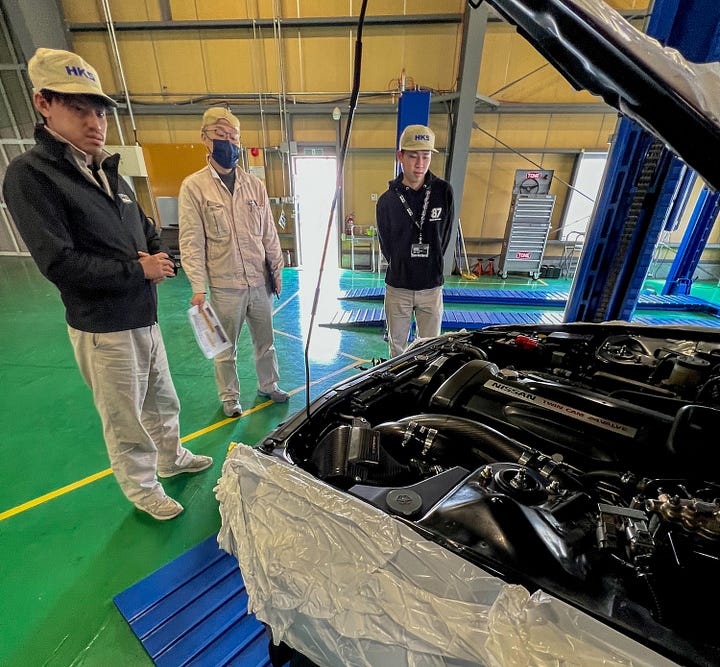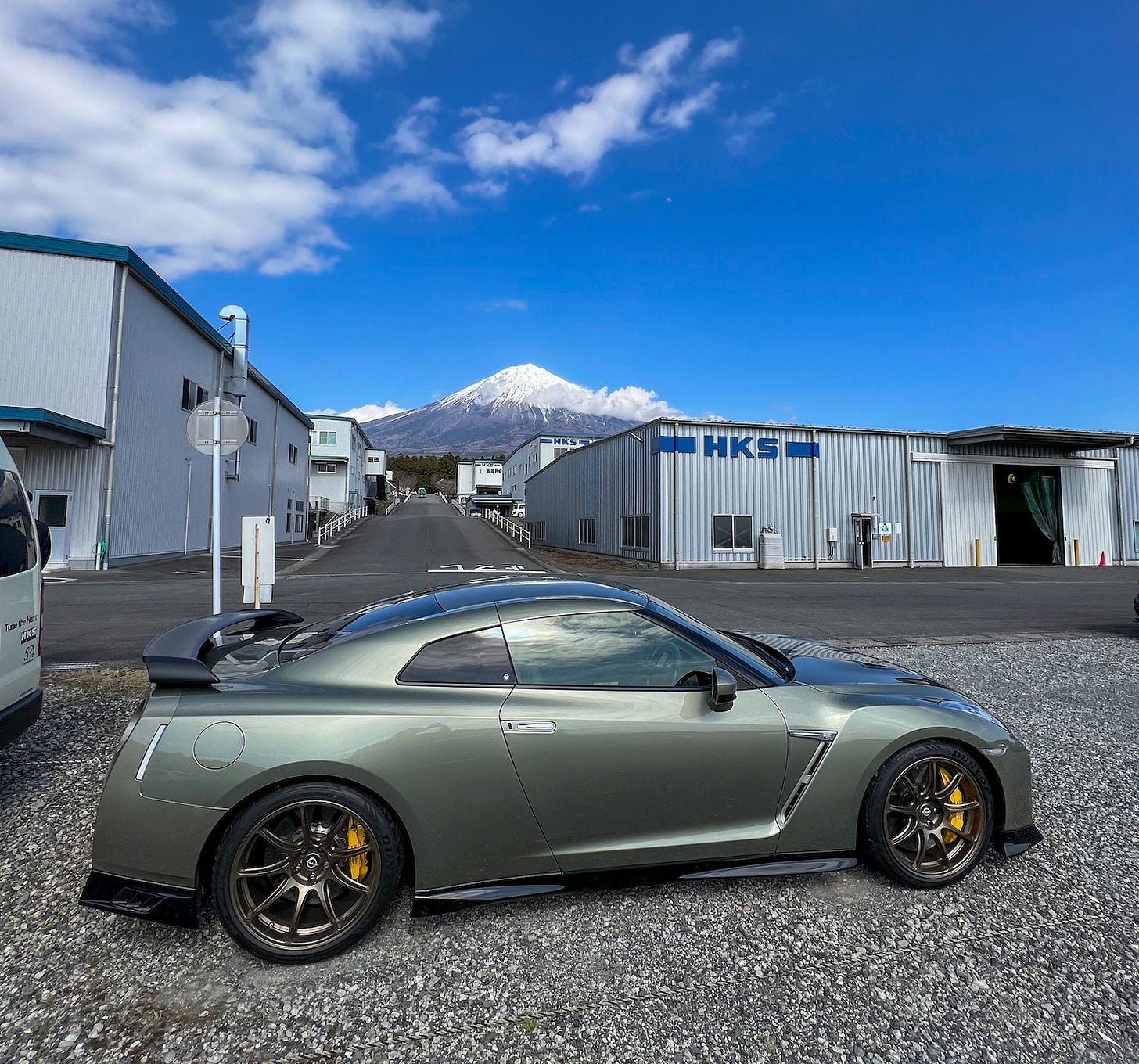Book Excerpt: Cult of GT-R, Chapter 7
My visit to the GT-R masterminds at HKS, Japan's biggest tuning brand
Welcome to our weekly installment with excerpts from Cult of GT-R, my newest nonfiction book about the history and controversy of the Nissan Skyline GT-R, available now. Every Monday, I’ll post a short section from a different chapter, plus photos and commentary, to give you a taste of what’s in the book. Click here to read previous excerpts from Chapter 1, 2, 3, 4, 5 and 6.
To buy Cult of GT-R, click here for my website or find it at your favorite online retailer. Enjoy!
Cult of GT-R: Chapter 7 Excerpt
ON MY SECOND DAY in Japan, I hopped behind the wheel of the R35 GT-R that Nissan had loaned me for the trip, and headed straight for mountain roads. Soon I was coasting downhill through the forest on the momentum of the GT-R’s mass, hurtling toward the ground, though I barely had to touch the car’s brakes. Carbon-ceramic discs are shockingly adept at burning speed.
After a few miles of gentle curves and spots of cherry blossom clusters, I reached level ground in Fujinomiya, a city of about 130,000 known for its natural beauty and chewy soba noodles. Sadly, I didn’t have time for lunch. I followed the nav system’s directions through another dense forest, slowed when I came to a sign reading “HKS” in bright white letters.
Japan has plenty of famous aftermarket companies scattered up and down its borders. GT-R owners I spoke with told me of pilgrim- ages they took to visit the legendary shops of Mine’s, Top Secret and Garage Yoshida. They mentioned these names as if they were temples. But HKS is less a shop and more a tuning behemoth. It is the Mount Fuji of Japan’s aftermarket.
I parked the GT-R in the gravel employee lot, the lowest point on the property, where I met my hosts, Akira Yoshinaga, a young rep in the overseas sales department, and Nobuhijo Uchiumi. We exchanged greetings—“Wow, you brought an R35!” Yoshinaga-san said—and then I followed their climb toward the first building on our tour. On the walk up, you follow a paved road, past warehouse-looking structures staggered up the hill on either side, each the size of a football field. HKS is famous for its wild paint schemes, green, orange, and purple splashed across a black base. The offices were meditative by comparison: a dull white topped with a dull blue trim running the length of the building. Some had “HKS” in blue letters at their top, and if you let your eyes follow those logos up the hill, a natural progression, they would eventually land on Mount Fuji itself. The poetry wrote itself.
My hosts led me into a quiet warehouse. Faded and dull green support beams framed plain white walls and a spotless ceramic floor. The room was where HKS keeps many of its old racecars—a black-and green 1980s dragster, an all-black Seat rally car, various Toyota drift projects with wild spoilers and stickers and metallic candy-red paint. In the center of the group was an R32 racecar, number 87, in the classic green-purple-orange splash graphics, with the same thick white wheels it had it used when it raced to victory over factory teams in the 1993 JGTC. Next to that is an R35 GT-R, much like the one I had been driving minutes earlier, but draped in the same paint scheme. It sported dive planes the size of boogie boards around its chin, add-ons that helped it set lap records at Fuji Speedway back in 2015.


These two GT-Rs are some of the most famous cars to ever come from HKS, but they represent the past. Today, HKS is looking toward the future. My hosts motioned me over to the bare steel shell of a car —an R32 GT-R skeleton—sitting by itself in the corner. Without a roof, doors, or hood, the stark silver frame looked as if it were from any old boxy sedan. Inside the engine bay, however, lay a secret project HKS has been working on nonstop for several years, one the company hopes will endear its brand to a new generation of fans.
The lump of metal parked in the engine bay was clearly an RB26. But it was unlike any I had seen. Nearly every piece of it was jet black, bright and demanding of attention. The intake manifold on the left, on stock GT-Rs a large cast-aluminum piece that quickly flakes and corrodes, had morphed into a sleek housing made entirely from woven carbon fiber. The turbocharger plumbing to the right was a network of thick and twisting vinelike tubes, in graceful matte black, fastened with fuchsia metal rings. Plaques and logos adorned the entire system, reading “Complete by HKS | Advanced Heritage,” a hint that this was HKS reaching above and beyond its typical work. This was an RB26 in an HKS acid dream.

This engine won’t hit public roads like this. Each of those parts were prototypes, first shown publicly by HKS weeks earlier at the Tokyo Auto Salon. At the time of my visit, they were still under development for production. (By the time they’re ready for purchase, the 3D-printed black turbo pipes will be switched to hand-formed carbon.) HKS is investing heavily in developing those parts the right way; the intention is to make them more reliable while improving power and efficiency. “We’re an aftermarket company, so performance must be increased, but the point is improvement,” he said.
In HKS’s Advanced Heritage department, three employees have been working full-time on new RB26 parts for the past two years. Take a step back from the flashy parts and the alluring power they promise, and the idea of something called Advanced Heritage can be baffling: Why would an aftermarket company pour so many resources into all-new parts for a 30-year-old engine? An engine that the original manufacturer, Nissan, doesn’t even produce any more? Devoting three full-time employees that could be working on HKS’s profitable powersports or government projects, instead of squeezing a few extra horsepower or miles per gallon from a low-volume engine that ended production two decades ago?
Akira told me to save my question for later, he had more he wanted to show me. We turned and headed out of that warehouse, up the road toward Fujisan before ducking into another bland-looking building off to the left. It was a mechanic’s garage, spotless, but with large windows that allowed natural light to shine onto the floors, which were painted a shade most people simply call “Japanese workshop green.” It was formerly used to develop engines for commercial vehicles like taxis, vans, and buses. Now it was empty, save for one pristine black R32 GT-R V-Spec II on a lift.

It was the boss’s car, Akira told me. It belonged to HKS President Daisuke Mizuguchi, whom I would soon meet. For the moment I learned about the man through his machine, a black V- Spec II that looked as if it had been Ziplocked and tucked away for three decades, not a scratch or dent in sight. Under the hood, I recognized the Advanced Heritage parts immediately. The intake manifold and engine itself were the stock, bulky Nissan components. But the right-side parts, the turbo pipes, the airbox, the windshield-washer reservoir, they were all sleek carbon.
These particular parts, the right-side parts, they said, will come to market first. HKS originally wanted to bring out the entire Advanced Heritage line of products at once, but the timing didn’t work out. They began to detail the exact construction techniques used for each part. I should have been listening, but I could only focus on the way the carbon weave made the twisting pipes appear to be in motion, perpetually slithering through the engine bay.


I snapped to moments later, right as they were saying something about how the full AH collection will produce 600 hp and help efficiency by about 15-percent. Just the right-side parts alone will retail for around $10,000, they told me. HKS was counting on the appetite of high-end customers looking for exclusive, high-quality parts from an established name re-entering the Skyline GT-R world with its first new parts in over a decade.
Yes, that made sense, I offered, but it’s still a pretty penny. Is the demand really there to justify this kind of investment?
Akira changed the subject, leading me out of the building. We’ll discuss it more with Mizuguchi-san, he said. We left the workshop and started walking toward yet another dull-looking building.
Akira owns a GT-R himself, he explained, an R33, which he prefers over the others for its longer wheelbase and high-speed stability. “You know Wangan?” he asked, referring to a form of high-speed highway racing. I nodded. “I like doing Wangan things,” he said.
I asked Akira’s associate, Uchiumi-san, what he drove. He had an R34 Skyline GT-T, he told me, the less-powerful, less-aggressive, non- GT-R model, power sent only to the rear wheels. I offered what were intended to be words of encouragement: that I was sure, one day, he’d be able to afford the GT-R he really wanted.
As it turned out, he didn’t want one. Uchiumi-san lives here, in Fujinomiya, he said, and he likes taking his GT-T to the local roads and racetracks where lighter weight and rear-wheel-drive can be an advantage, especially at lower speeds and in tighter turns. I hadn’t really thought of that, but it makes sense. I could certainly think of one application where it works perfectly.
“So,” I said, “Wangan for you? And touge for you?” They lit up, both answering at once: “Yes!”
About This Chapter
What could beat a drive through Mount Fuji roads in an R35 GT-R? Only a trip to HKS headquarters, really. This was one of the experiences during my research that I felt truly lucky to have. It’s also one that ‘Cult of GT-R’ readers have been most interested in. You can watch my recent interview with the RHD Guys Podcast right here, or listen to it wherever you find podcasts, where we discuss the HKS visit and its impact on the GT-R tuning world in detail.
Check out Carrara Media on Instagram, Twitter and Facebook and visit our store to order one of our many fine books and eBooks.





